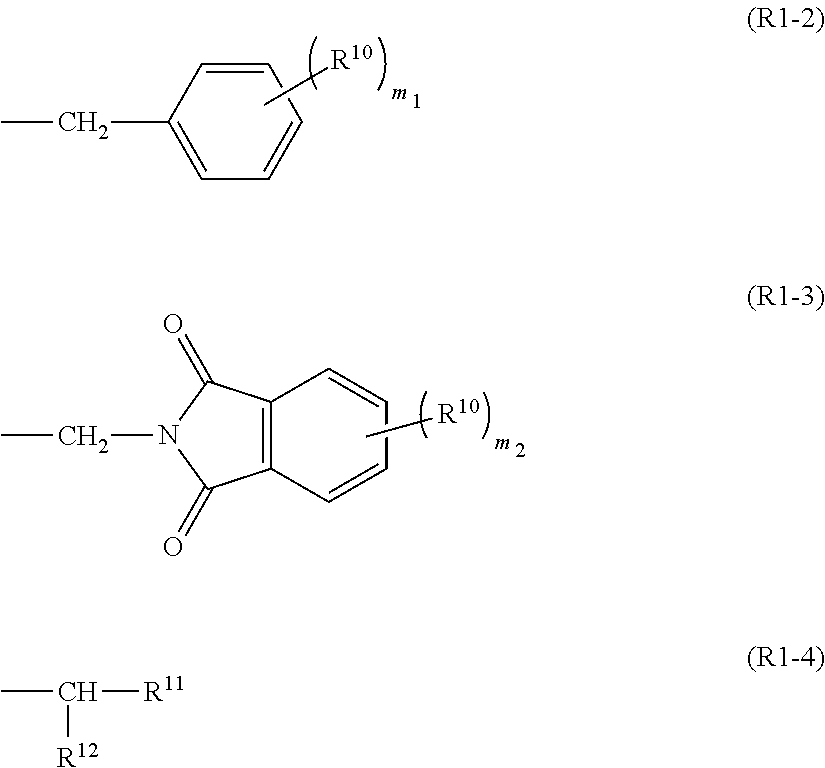Resist pattern-forming method, resist pattern-forming radiation-sensitive resin composition, and resist film
- Summary
- Abstract
- Description
- Claims
- Application Information
AI Technical Summary
Benefits of technology
Problems solved by technology
Method used
Image
Examples
synthesis example 1
Polymer (A-1)
[0182]38.77 g (40 mol %) of the monomer (M-1), 56.13 g (55 mol %) of the monomer (M-3), and 5.10 g (5 mol %) of the monomer (M-7) were dissolved in 100 g of 2-butanone, and 4.97 g (7 mol % based on the total number of moles of the monomers) of AIBN (initiator) was added to the solution to prepare a monomer solution.
[0183]A 500 ml three-necked flask equipped with a thermometer and a dropping funnel was charged with 100 g of 2-butanone, and purged with nitrogen for 30 minutes. The inside of the flask was then heated to 80° C. with stirring using a magnetic stirrer. The monomer solution was added dropwise to the flask over 3 hours using the dropping funnel. The monomers were polymerized for 6 hours from the start of dropwise addition of the monomer solution. After completion of polymerization, the polymer solution was cooled with water to 30° C. or less. The reaction solution, 300 g of hexane, 1200 g of methanol, and 60 g of water were poured into a separating funnel, and ...
synthesis example 12
Polymer (B-4)
[0185]13.42 g (30 mol %) of the monomer (M-8), 6.10 g (10 mol %) of the monomer (M-9), 3.20 g (10 mol %) of the monomer (M-10), and 27.28 g (50 mol %) of the monomer (M-11) were dissolved in 100 g of 2-butanone, and 4.03 g (10 mol % based on the total number of moles of the monomers) of AIBN (initiator) was added to the solution to prepare a monomer solution.
[0186]A 500 ml three-necked flask equipped with a thermometer and a dropping funnel was charged with 50 g of 2-butanone and 6.10 g (10 mol %) of the monomer (M-10) to effect dissolution, and purged with nitrogen for 30 minutes. The inside of the flask was then heated to 80° C. with stirring using a magnetic stirrer. The monomer solution was added dropwise to the flask over 3 hours using the dropping funnel. The monomers were polymerized for 6 hours from the start of dropwise addition of the monomer solution. After completion of polymerization, the polymer solution was cooled with water to 30° C. or less. The polymer...
example 1
[0193]100 parts by mass of the polymer (B-4) obtained in Synthesis Example 12, 5 parts by mass of the polymer (A-1) obtained in Synthesis Example 1, 12 parts by mass of the acid generator (C-1), 6.2 parts by mass of the acid diffusion controller (D-1), and 100 parts by mass of the uneven distribution promoter (F-1) were mixed. The mixture was dissolved in 2900 parts by mass of the solvent (E-1) (solvent [E]) and 1250 parts by mass of the solvent (E-2) (solvent [E]) to obtain a mixed solution. The mixed solution was filtered through a nylon filter (pore size: 10 nm) and a polyethylene filter (pore size: 5 nm) to prepare a radiation-sensitive resin composition. The radiation-sensitive resin composition is hereinafter referred to as “composition (J-1)”.
PUM
| Property | Measurement | Unit |
|---|---|---|
| Surface free energy | aaaaa | aaaaa |
| Sensitivity | aaaaa | aaaaa |
| Content | aaaaa | aaaaa |
Abstract
Description
Claims
Application Information
 Login to View More
Login to View More - R&D
- Intellectual Property
- Life Sciences
- Materials
- Tech Scout
- Unparalleled Data Quality
- Higher Quality Content
- 60% Fewer Hallucinations
Browse by: Latest US Patents, China's latest patents, Technical Efficacy Thesaurus, Application Domain, Technology Topic, Popular Technical Reports.
© 2025 PatSnap. All rights reserved.Legal|Privacy policy|Modern Slavery Act Transparency Statement|Sitemap|About US| Contact US: help@patsnap.com



